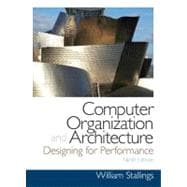For undergraduates and professionals in computer science, computer engineering, and electrical engineering courses.¿
Learn the fundamentals of processor and computer design from the newest edition of this award-winning text.
Four-time winner of the best Computer Science and Engineering textbook of the year award from the Textbook and Academic Authors Association, Computer Organization and Architecture: Designing for Performance provides a thorough discussion of the fundamentals of computer organization and architecture, covering not just processor design, but memory, I/O, and parallel systems.Coverage is supported by a wealth of concrete examples emphasizing modern systems.








